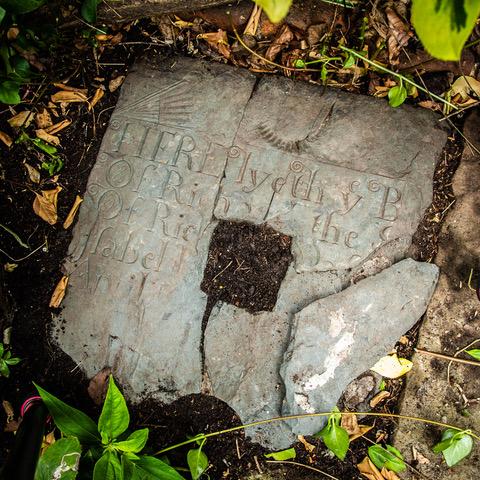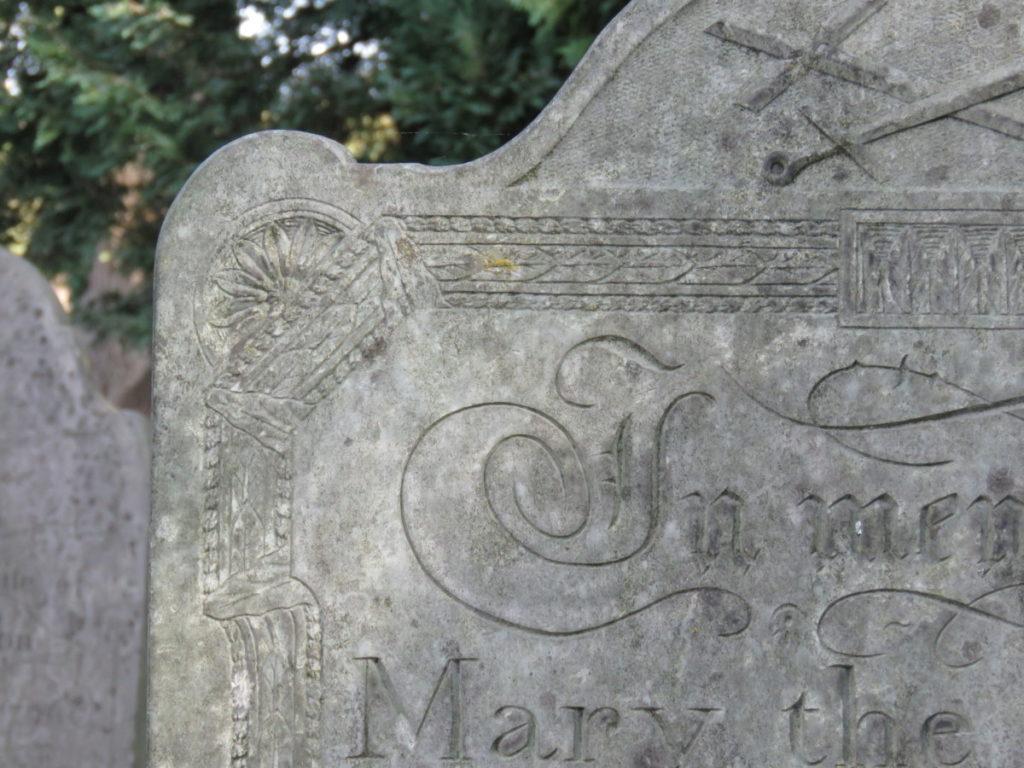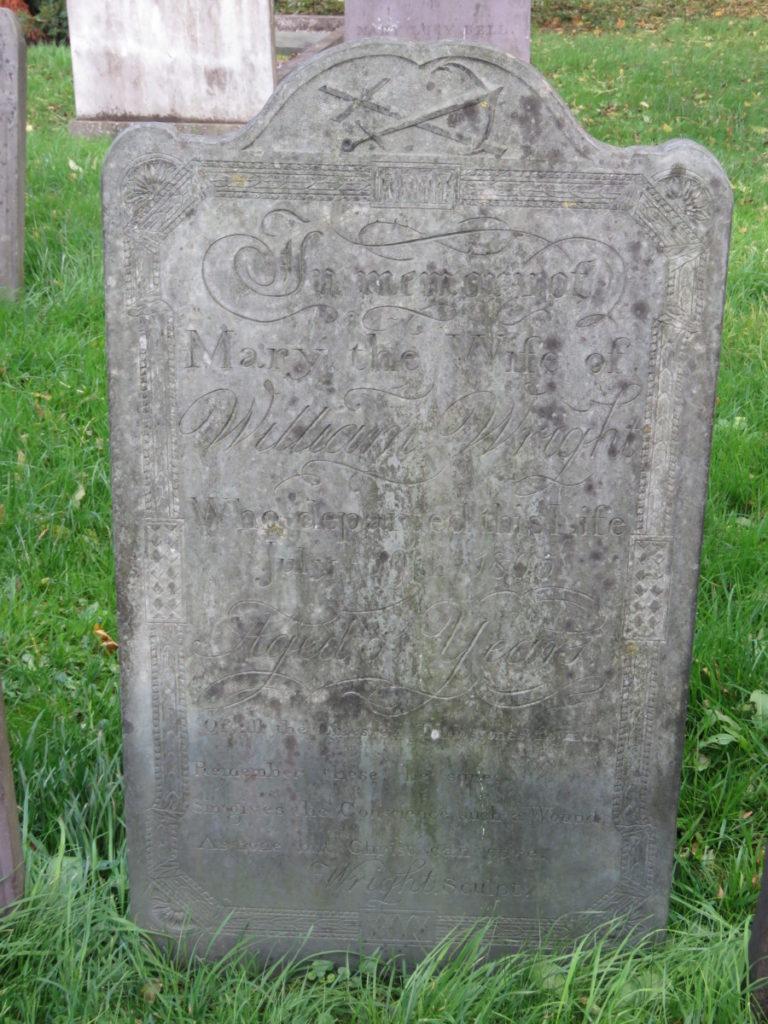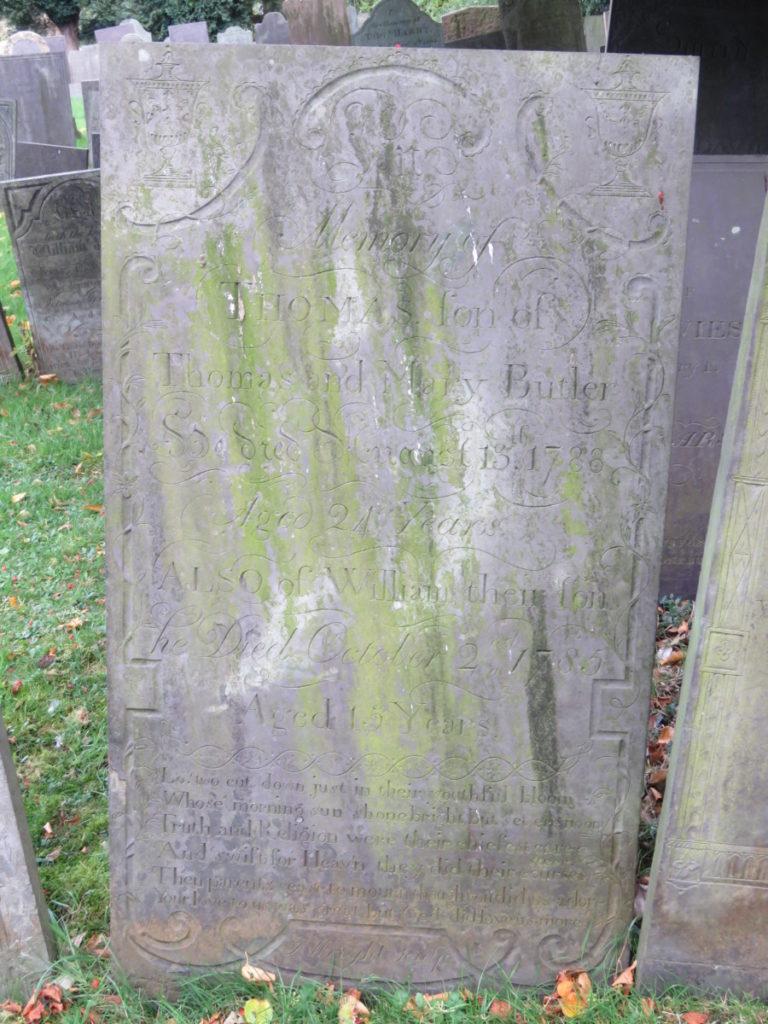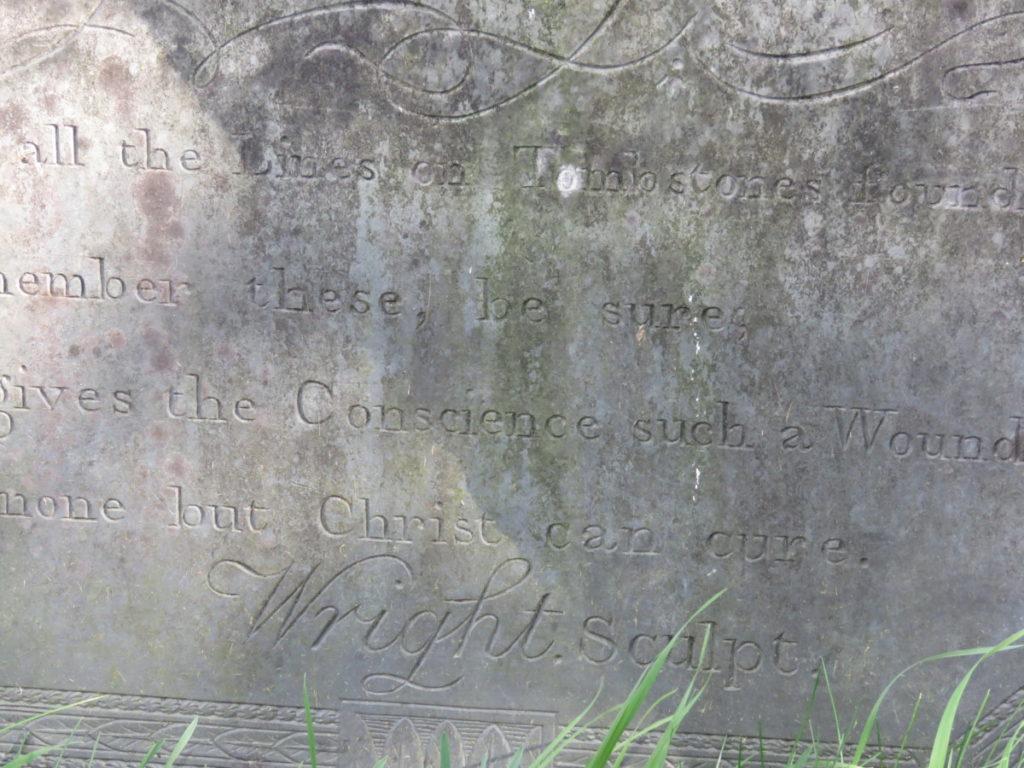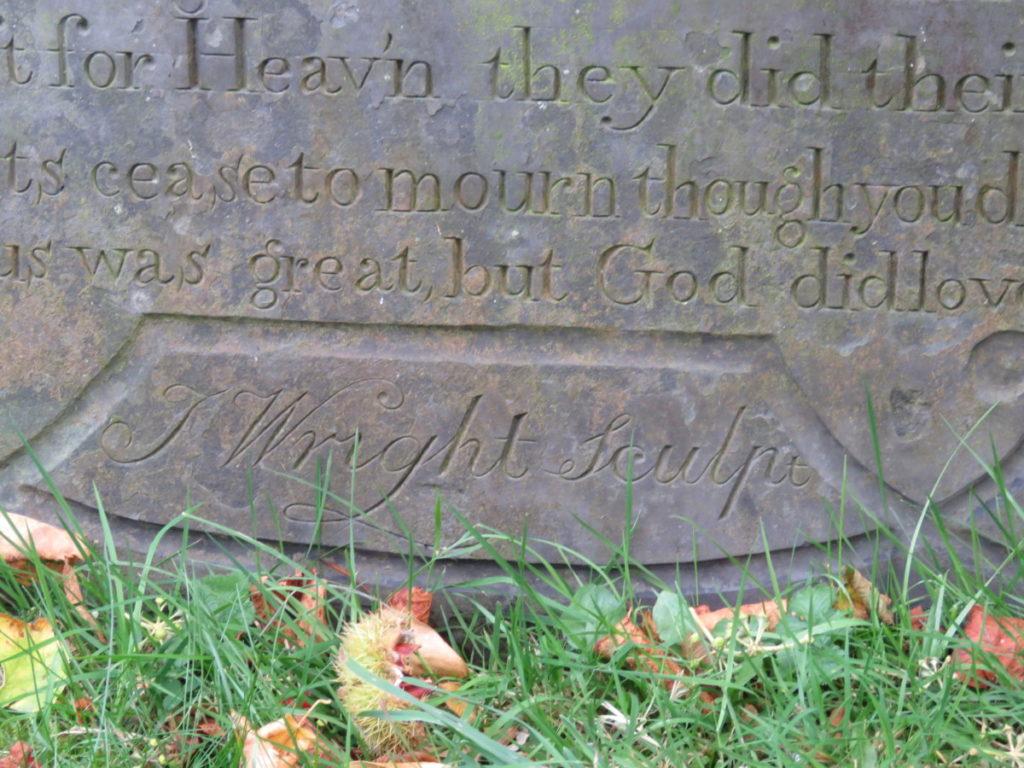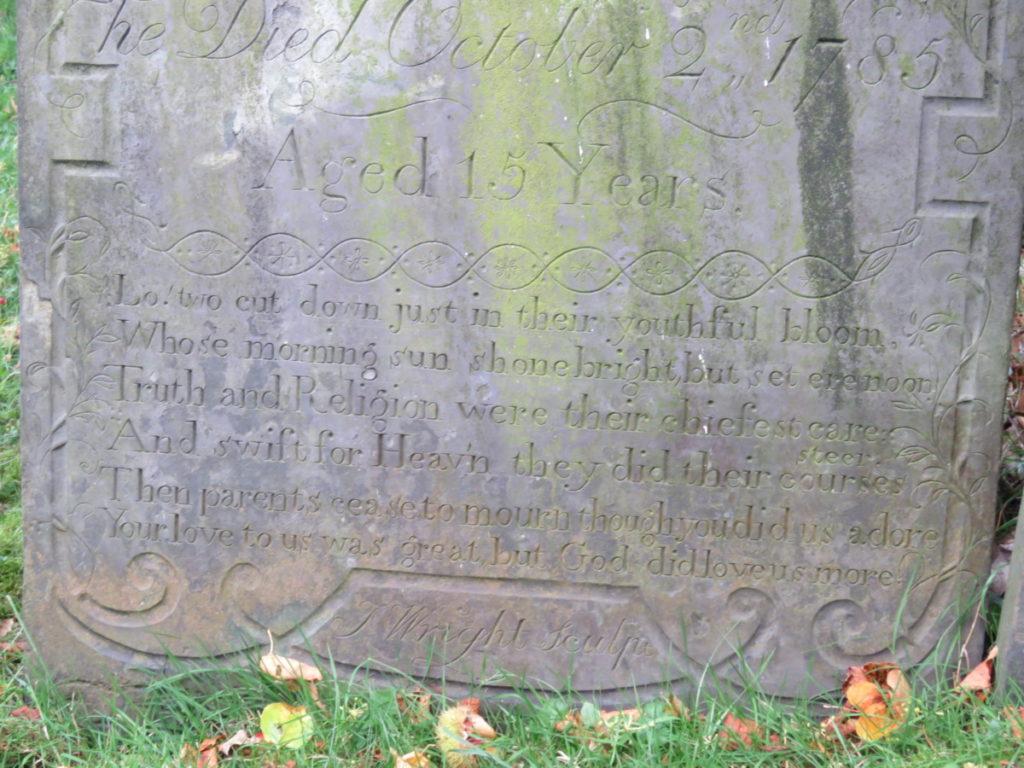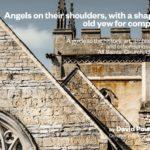The owners of Cobblestones recently explained their find: “(We) currently live at Cobblestones and the gravestone is in the front garden. It is about a third of the original, and has been cut into, probably to be used to support a post as there is a square taken out of the centre. We found it when we were clearing the back garden, over thirty years ago (…) There is, apparently, an important link between John Wright and the production of these angels. John Wright was the first person to own our house in 1797, so that could also be of interest, although he must be the grandson etc. of the masons who cut these gravestones.”
There are a number of explanations for this stone being found here but we are still firmly in the realms of speculation:
- The stone may have been either a trial slate but the names and dates are identifiable in parish records which make this unlikely.
- It may have been damaged in the carving and a separate replacement made. However, there is no surviving stone in the graveyard for these individuals even though Parish records confirm their presence in this Parish; but this isn’t confirmation in itself because gravestones do disappear over time.
- Sometimes, headstones are removed so that additional, later burials can be added; it is possible that this stone was removed in this way but, for some reason, it was never returned. With Belvoir Angels, these extra engravings are sometimes added to the back of the headstone – ‘double-sided’; it hasn’t been possible to confirm yet whether there is anything on the reverse of the Cobblestones Angel.
It appears that large numbers of Belvoir Angel gravestones have been lost over the years; either they’ve been destroyed, deteriorated beyond recognition or moved/removed for various reasons. Our modern outlook is rather different from those of 300 years ago, but this find does have an uncomfortable aspect: whilst some of the reasons for gravestones being found outside the graveyard (trial pieces or ones with mistakes on which then weren’t used) are understandable, other reasons are less so. If this was a proper grave marker for a genuine burial which was then removed (maybe for further names to be added) but not returned to the graveyard – that seems very sad. its reuse as a foundation stone for a post or a piece of machinery is even more so but slates/stones couldn’t be wasted. Different times, we know.
The Inscription:
From what remains of the inscription it has been confirmed that the headstone relates to the death of Richard Daft who died in Hickling in April 1707, age 21.
- Richard Daft of Hickling, a bachelor, aged 23, married Isabel Couleshaw (Collishaw), a spinster aged 21, of the same, at Nottingham St Peter, by licence, on 29th November 1684
- Their son, Richard, was baptised in Hickling on 20th December 1685.
- Richard senior died soon afterwards; ‘Richard Daft at the Dovecote’ was buried at Hickling on 4 March 1685/86.
- ‘Isabel Daft, widow,’ then re-married to William White, a widower, in Hickling on 6th December 1696. At the time she would have been aged 32.
- In this way, William White became step-father to her son Richard, then aged 11.
- Richard junior died in 1707 and was buried on 21st April (April is still readable on the gravestone). He would have been 21.
- An admon and bond for him, dated 2nd May 1707, is signed by ‘Isabel White, mother, wife of William White, yeoman, of Hickling.’
- William White was buried in Hickling on 4th May 1712 and Isabel White was buried there on 12th January 1742/43 (she would have been aged 79).
- There is no surviving gravestone in Hickling churchyard for either William or Isabel White and this may explain the removal of the Cobblestones headstone – perhaps, the intention was to add these later engravings/burials.
- According to Parish records, William and Isabel had four children during their marriage; although further work is needed to identify whether any or all of their children survived into adulthood.
- There are references to ‘The Dovecote’ and this is likely to be the branch of the Daft family recorded as ‘of the Dove coat’ in the Protestation returns of 1642.
The Wright family (stonemasons?).
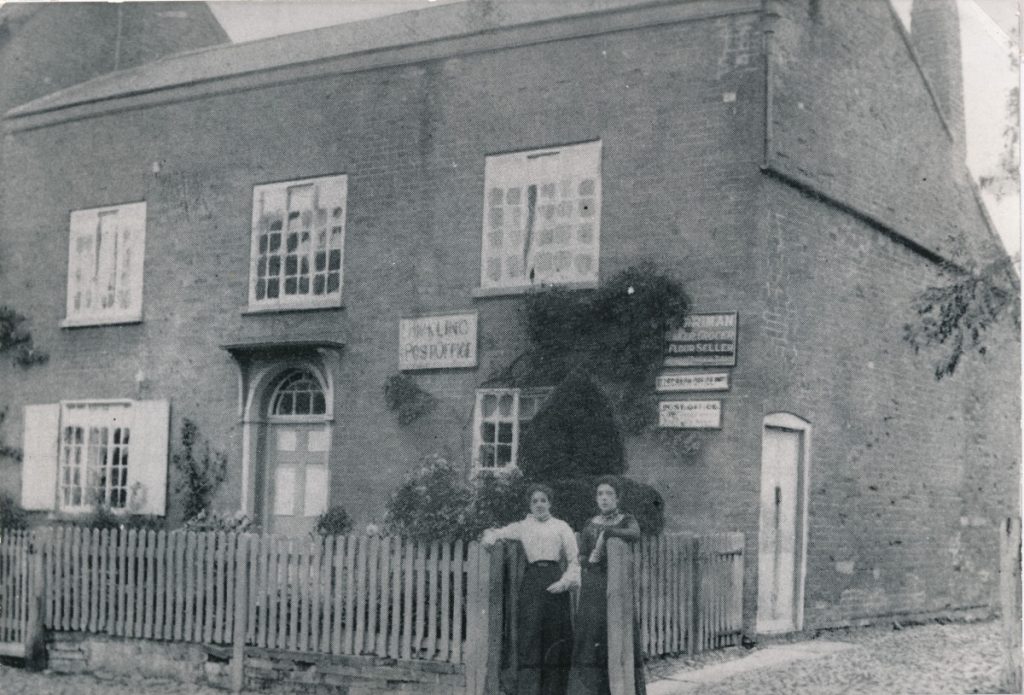
More work is needed to really explore this but the finding of this headstone at Cobblestones may be a significant clue in the search for the identity of the craftsman/men responsible for the Belvoir Angel carvings. Almost a third of the surviving Belvoir Angel headstones can be found in the neighbouring villages of Nether Broughton, Upper Broughton and Hickling; this seems to imply that these villages formed the craftsman’s ‘locality’.
There is just one unreferenced comment linking the name of ‘Wright’ to headstones and this can be found in a Thoroton Society article by Maurice Barley in 1938; he writes, “churchyards of south east Nottinghamshire have many interesting examples of the work of John Wright of Hickling (fl 1790-1830)”. Elsewhere, this John Wright is referred to as a bricklayer but this reference links him to the carving of headstones, too.
A John Wright was the first owner of Cobblestones in 1797; in the Deeds for the property he is referred to as a bricklayer. This places him later than the craftsman/men responsible for the Belvoir Angels but he could be a son or grandson.
- The presence of an old Belvoir Angel headstone at the property could simply be a coincidence but it might also indicate that the headstones are part of an ongoing family business.
- There are several Wright family graves in Hickling churchyard from the 1800s and later; and a more detailed family history research may help to make any connections that might exist. There is one that may be of interest, though:
- Mary Wright, the wife of William Wright, died July 19th 1805
- It is prominently marked as the work of “Wright Sculpt”
- The carving has no resemblance to the Belvoir Angels craftsmanship; it is in the more florid style of the time. However, there may be hints at some of the earlier symbolism, particularly in the stylised feathers used as a border.
- There is also a second headstone prominently marked as the work of “J Wright Sculpt”; this is a Butler family grave recording the deaths of Thomas Butler (age 24) in 1788 and William Butler (age 15) in 1785 – they are the sons of Thomas and Mary Butler.
- The stonemason’s signature is very similar to the one which appears on Mary Wright’s headstone but, of course, this is a carving and not handwriting.
- There are no hints of a stylistic link back to the Belvoir Angels on this stone.
There are no surviving Wright family Belvoir Angel headstones in Hickling. However, there are Wright family Belvoir Angel headstones in Nether Broughton churchyard in the early 1700s and it seems possible that these are the family of the original stonemasons/craftsmen and that the family later arrived in Hickling.
The inscription on Mary’s headstone reads as if there may be a story behind it …
“Of all the lines on tombstones found remember these, be sure sin gives the conscience such a wound as none but Christ can cure. Wright Sculp”
(Much more research is needed (particularly of the Wright family history) if we are to turn speculation into possibility or certainty.)
Angels on their shoulders, with a shapely old yew for company by David Powell (2020)
Please click on the front cover image (right) to open his wonderful chapter on the Belvoir Angels which includes the Cobblestones Angel. Our thanks to David for his permission to publish it here.
Please contact us if you are interested in the full book and we can put you in touch with the author.

